3 March 2013
- Kayak trip on the Khwae Noi River in Central Thailand (Kanchanaburi area) from Sai Yok Yai until Wang Krachae as part of the Khwae Noi River Kayak Route.
- Technical data:
- We started off at Sai Yok Yai near the bridge leading to the AH123 just opposite a resort at 0945 Hr for a day of kayaking on the Khwae Noi River. There was a good current estimated at 5 Km/Hr and there were no obstructions on the river. We arrived at Hin Tok River Camp around 1400 Hr, where we stopped for 30 minutes in order to coordinate lodging. We continued downstream for half an hour and arrived at our overnight destination at 1500 Hr. We took no lunch along this stretch, as no catering was available (raft houses served only food in the evening).
- The weather was sunny and warm. Max. Temperature was 35.3 C and the wind blew southeast at 18.5 Km/hr, but the latter was hardly tangible in the Khwae Noi valley.
- Technical data of the trip was as follows: Total Distance: 31.5 Km; Moving Average: 7.3 Km/Hr; Overall Average: 6.1 Km/Hr; Maximum Speed: 14.3 Km/Hr; Moving time: 4 Hr 17 Min; Stopped Time: 51 Min; Total Time: 5 Hr 8 Min.
- Number of participants: 2 (Pat & Sean)
We woke up to a nice peaceful morning on the river Khwae, the sleep had not been that good, a combination of weary body as well as the paper thin walls of the rooms which allowed the blaring disco music from the restaurant to penetrate until the early hours of the morning. We went for breakfast, which consisted of cold eggs, toast and cardboard sausages that gave very little energy for the day ahead, even so, we gulped it down; it was better than nothing as on this trip we would not stop for lunch on any of the legs. The coffee however was OK and warranted a 2nd cup. Thereafter we went back to our rooms to prepare our things for the day ahead; while there we saw a raft full of tourist wearing life jackets being pulled up the river by a long tail boat, the boat then stopped and they all jumped into the water to float downstream to their hotel. It looked like fun, but we were later told by the hotel owner that the river was dangerous, and that there was a death there almost every week. It added to our respect to the river which had been growing since the events of the day before.
We had been told by the staff the night before that the current would be low in the morning, but this was apparently not the case today, the river flowed as strongly as it had the day before; launching the kayaks in front of the rafts would be risky and could lead to capsizing. We then proceeded to scout the establishment in an attempt to find a safe place to launch. The front facing the main river flow was out of the question, so we looked at the back of the rafts where they were closer to the bank and the water flow was reduced. This looked good, but there were no obvious places to launch; eventually we did manage to find a small landing between the kitchen and the laundry that looked suitable. However even this was not without risk as the area between the rafts and the bank was traversed by numerous mooring lines as well as the main water supply pipe to the raft complex. While we were confident that there was enough space to clear it, it was going to be tight! We approached the owner with our plan and even though she was nervous about us damaging the water pipe, our assurances eventually won her over and she kindly agreed to allow us to launch from the kitchen, even going so far as to direct her staff to help us out with moving our kayaks.

At 08h20 we launched from the kitchen and even so found the flow quite strong, the water pipe was negotiated without incident and we then found ourselves back in the full flow of the river ready to tackle day 2 of the trip; destination Wang Krachae via Hin Tok. The first track of the day to Tha Sao, also known as Nam Tok (waterfall), is the nicest of all eight tracks and leads through the Sai Yok National Park, famous for its caves, falls and the smallest mammal in the world, the Kitti's Hog-nosed bat. It was here that the famous Russian-roulette scenes with Robert De Niro and Christopher Walken for the American war drama film "The Deer Hunter" were shot. It was also a place of suffering in World War II as in the area of Kin Sai Yok there were four working camps for prisoners of war.

We pushed off down the river, the sun still peeking through the tall bamboo growth; it was still relatively cool and peaceful – ideal kayaking conditions. We found ourselves traversing a beautiful landscape of limestone mountains covered in forests and bamboo; in the morning light the river was a deep green and crystal clear. However, all too soon the wonders of the natural park gave way to the most commercial section of this river as we came around a bend and happened upon the first of many floating hotels on this section popular for the waterfalls. Around each bend we would pass a new hotel but eventually after one hour, we came across our first waterfall, although a small one. Unfortunately, even that had a raft anchored in the front of it, which partially hid the waterfall from our sight, but the blow was softened by the sight of the girls on board waving and smiling at us! A bit further along we arrived at the Sai Yok Yai waterfalls, whose waters glided over a cliff into the Khwae Noi River. There are two falls, at least for this period of the year and a suspension bridge links the two sides, dotted with raft-lodges. The whole area is crowded with rafts, unfortunately spoiling the magic of this beautiful place.
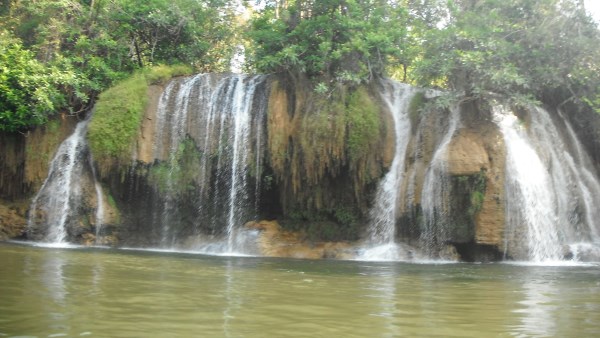
After the second waterfall we turned the bend and were confronted with a spectacular towering wall of rock that wrapped for a few 100 meters around the bend, high soaring cliffs and undercut rock banks were visible along its length. It also offered welcome shade and a return to tranquility as we left the raft lodges behind us.

As the river twisted around the following bends we came across more of these sheer stone faces, equally as impressive. At the end of the third one, near Ban Mae Nam Noi we passed under a bridge and then came across the confluence of the Huai Mae Nam Noi and the Khwae Noi River. A few hundred meters west of this confluence, the tributary Huai Mae Nam Ko runs into the Huai Mae Nam Noi, some old military maps indicate that the latter also contains some waterfalls.
We continued past the confluence and passed a long but not too serious rapid before hitting a dog leg in the river that changed the route to a south easterly direction. Here there was a distinct change in the scenery, the river was long and straight and the banks were featureless, in stark contrast to the sections paddled earlier in the morning. In addition, the sun was getting up and it was getting uncomfortably hot, it was now a matter of putting the head down and putting in the time and effort to make progress, which was measured every hour. Even so it was tough going and as he paddled Sean mentally bookmarked this section the ‘dead zone’ due to it featureless terrain and hot nature. However all bad things come to and end, and after a long hour paddle the terrain changed again as big hills became visible and the plateau to the east, that would flank the river for the rest of the day, came into view. At 10h45 we again encountered a large number of rafts in a bend devoid of life with exception of some staff; this is due to the fact that the Rafts tend to cater to tourists mostly in the evening when they arrive after a day out sightseeing. After that is was just us and the river again as we paddled past limestone cliffs covered in nature at ever bend. Here and there the water boiled a bit because of rocks in the riverbed, but nothing really bothered us. At about 11h30 we arrived at the Pechmaneekan Resort with its beach and a bit further down, the Hin Tok River Camp.
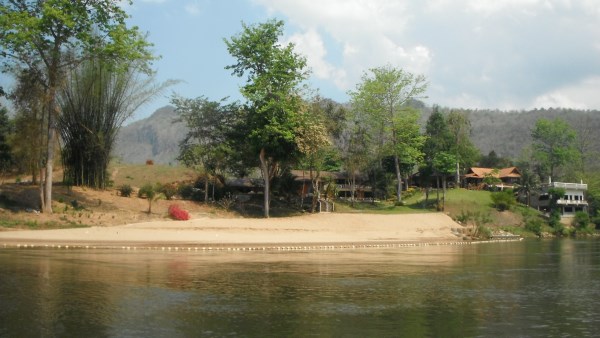
In the Hin Tok (Stone Fall) area there were six working camps for prisoners of war during the construction of the Thailand-Burma Railway in World War II, of which three camps were on the river. The railway track between Hin Tok and Tampi was notorious for its many deaths in constructing the Death Railway. The Konyu-cutting or Hell Fire Pass alone, consisting of two cuttings, cost the lives of 700 prisoners. The work commenced on 25th April 1943 and was completed mid-August, with prisoners forced to work 12 to 18 hours per day. We took a break near the suspension bridge just two kilometers below the Hell Fire Pass, the forecast for the day was a temperature of 40 degrees; we were only sitting in a kayak, paddling with the current for a couple of hours and we were already tired. Can you imagine what those prisoners felt; completely underfed, thirsty, sick, tired, covered with wounds, bare foot and regularly beaten by their Japanese and Korean guards? You succumbed, you died. That was really hell on earth.
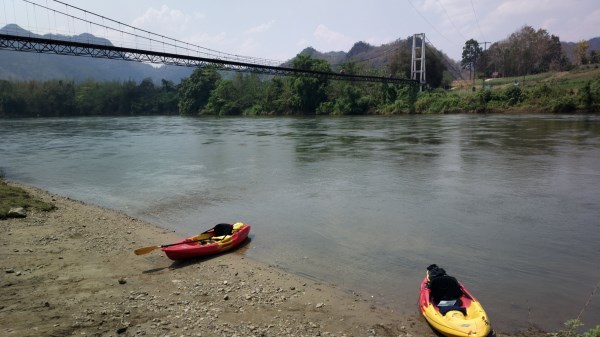
The hell was too much for Sean and he divided into the Khwae Noi to cool off. He did not venture too far into the river though, as the current would have swept him away, but after a few hours sitting in a kayak in the hot sun, the allure of the ice cool water was too much to resist, and well worth the risk! Meanwhile Patrick sat quietly on a stone under the shade of a tree as a rabble of small butterflies flew around. He watched the river flowing by, ate some snacks and sipped a sport drink while the Buddha at the temple on the opposite bank gazed back, or was it the other way around? Eventually we had to drag ourselves out of the cool, relaxing surroundings and carry on, it was not yet noon and we were already on the second track of the day; we lazily got ready to leave and pushed the kayaks over the pebbles into deeper water. Half an hour later we passed the massive rafts of Khwae Noi Jungle Rafts; all pretty deserted as the tourist season was over.
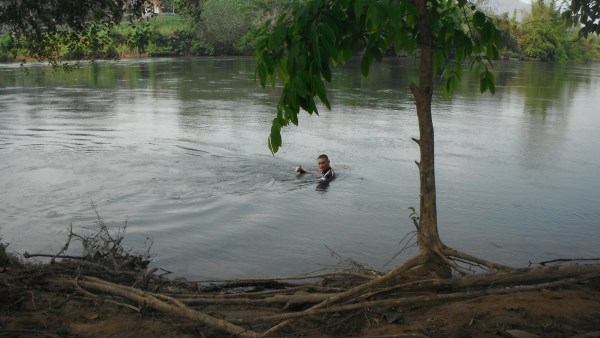
We continued drifting past the beautiful landscape; on this section the hills and plateau were their closest to the river and the view was spectacular. The river meandered through the valleys disturbed from time to time by accommodation rafts on the bends of the river. It was on this section that we also encountered the most river traffic as we passed processions of long tail boats ferrying guests to the resorts upstream. This made for challenging paddling conditions as the wake of the boats collided with the strong flow of the river creating big confused waves. Shortly before 14h00 we paddled past a 4-storey hotel building of the River Kwai Village Hotel, the biggest hotel we would encounter on the river. For Sean it was like stepping back in time as he had overnighted in this same hotel on his only previous trip to this area 10 years ago.
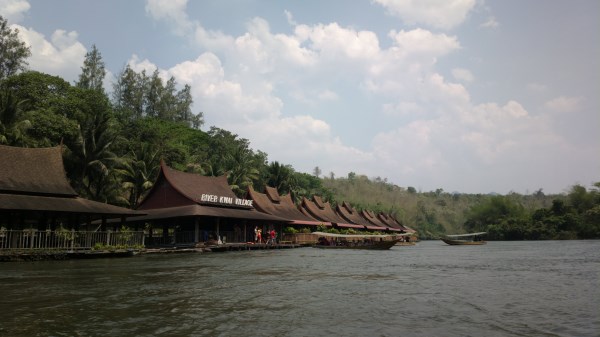
About 1 Km later we passed the Rock Valley Hot Spring and Fish Spa, again we were nearly caught out as while taking pictures and returning the waves of the massage girls, a rapid popped up on the bend! This we managed to negotiate without issue though, we were now old hands. We continued onwards in the hot afternoon sun, however there were some clouds forming and it looked like it could rain later. At this stage the closed valley of the HinTok area started to recede as we came onto a more open flood plain and as the vista opened up we were now able to see the massive mountain peaks towering to the West along the Thai/Burmese border, truly spectacular.
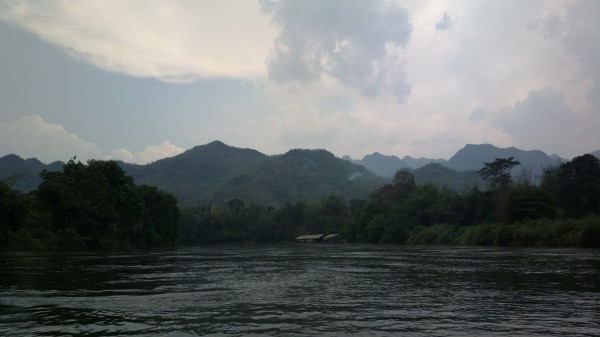
We continued to pass resorts upon resort until we arrived in the area of Wang Krachae. We passed under the suspension bridge near the River Kwai Boutique Resort, which was now in a dilapidated state and no longer in use, then continued under the main bridge and passed the Ban Rai Rim Than Resort.
We were now in a relaxed state again, at the end of the most enjoyable section of the trip, and with only five kilometers on the map to go until our stop for the night and a chance to rest our weary minds and bodies. As we glided past each resort we would check it against the map to monitor progress, suddenly Sean noticed a sign at one of the resorts, what the..? "Phung Waan Resort!" he shouted; it couldn’t be, our destination was supposed to still be 5 Km downriver! However, with the river flow still strong, a decision had to be made, he started paddling furiously towards the landing platform which was rapidly passing by, and as he came alongside he then turned his kayak and paddled hard against the stream to find a place to secure. As usual there was little to hold onto and he eventually had to make do with the very end of the pontoon where he was able to secure the kayak and climb out.
Meanwhile, Patrick had been taken by surprise; he saw Sean make a dash for the side of the landing platform, but to do the same maneuver would have taken him too far downstream with the risk that he would be swept past the platform totally, or so he thought. His only choice was to paddle to the inside of the platform where hopefully the flow was reduced and he could find a way to get out. He focused in trying to land on the river bank and swiftly turned his kayak in that direction. However, he had only made two to three meters when he was suddenly caught in the stream flowing towards the pontoon on the inside of the platform which threw him against the floating barrels of the bridge leading to the raft. He was trapped, damn, what a current! Glued perpendicular against a barrel, he fixed the kayak rope to the metal construction, but in doing this, the river filled his boat. As the kayak started to sink he felt it gliding under the floating bridge taking him with it. He did not have much time left; he quickly abandoned ship and hoisted himself onto the raft just as the kayak, turned over and got stuck fast under water between two barrels; he saw the bottom of the kayak bending and really feared it would break. By this time he had been joined by Sean and the two of them sprung into action to save the distressed vessel. Sean stood with all his weight on the top of the kayak to release it from under the pontoon; the power of the water was immense! Slowly, the kayak came free and they were able to maneuver it clear and back into the open flow and then manhandle it onto the walkway. Fortunately, although everything had been submerged, all Patrick’s gear and equipment was still secure to the boat and nothing had been lost.
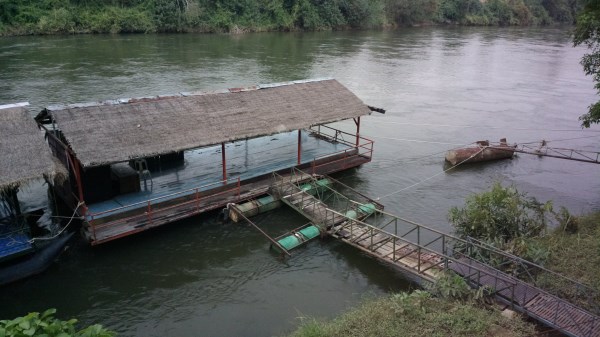
We re-gathered ourselves and set about finding if this was the correct resort or not. Sean set of to find the reception, the resort however was huge and it took a while to find, the walk after kayaking for 60 Km, drained the last ounces of energy he had left in his body. Eventually he was able to find the reception and confirm that this was indeed the place. He went back and informed Patrick, it was a relief to know we did not have to re-launch into the river again!
We carried our kayaks up to an open pavilion where we secured then for the night. We then checked in at the reception then got a welcome lift to our rooms in a shuttle van, passing a zoo with wild deer on the way.
Once in his room Patrick found out that his waterproof bag was not so waterproof after all, it had been submerged for quite a while and water had found a way inside; half of his gear was wet. After checking the manufacturer instructions he realized that it was his mistake, he had only folded the rim three times (as there was too much gear inside) while the manufacturer recommended four- the terrace became soon a big drying rack! Having cleaned up everything he then joined Sean who was recovering beside the huge deserted pool.
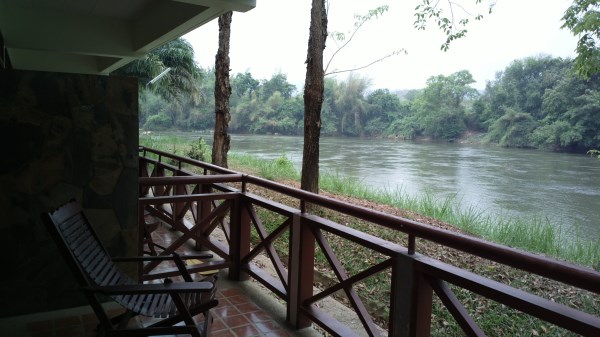
After a refreshing swim we went back to the rooms to freshen up then at 18h00 went out for drinks and diner, the lounge and bar area was had a nice atmosphere, airy and open with a view towards the river, as well as a high ceiling festooned with geckos. We then adjourned to the restaurant below and ordered one of the set menus consisting of a starter, soup, three main courses, rice, ice cream and coffee; this was our best dinner in the three days and help to replenish the energy supplies. After having beaten the hunger, we retired back to our rooms to reflect on a magnificent day of adventure and dream of what the next day had in store.